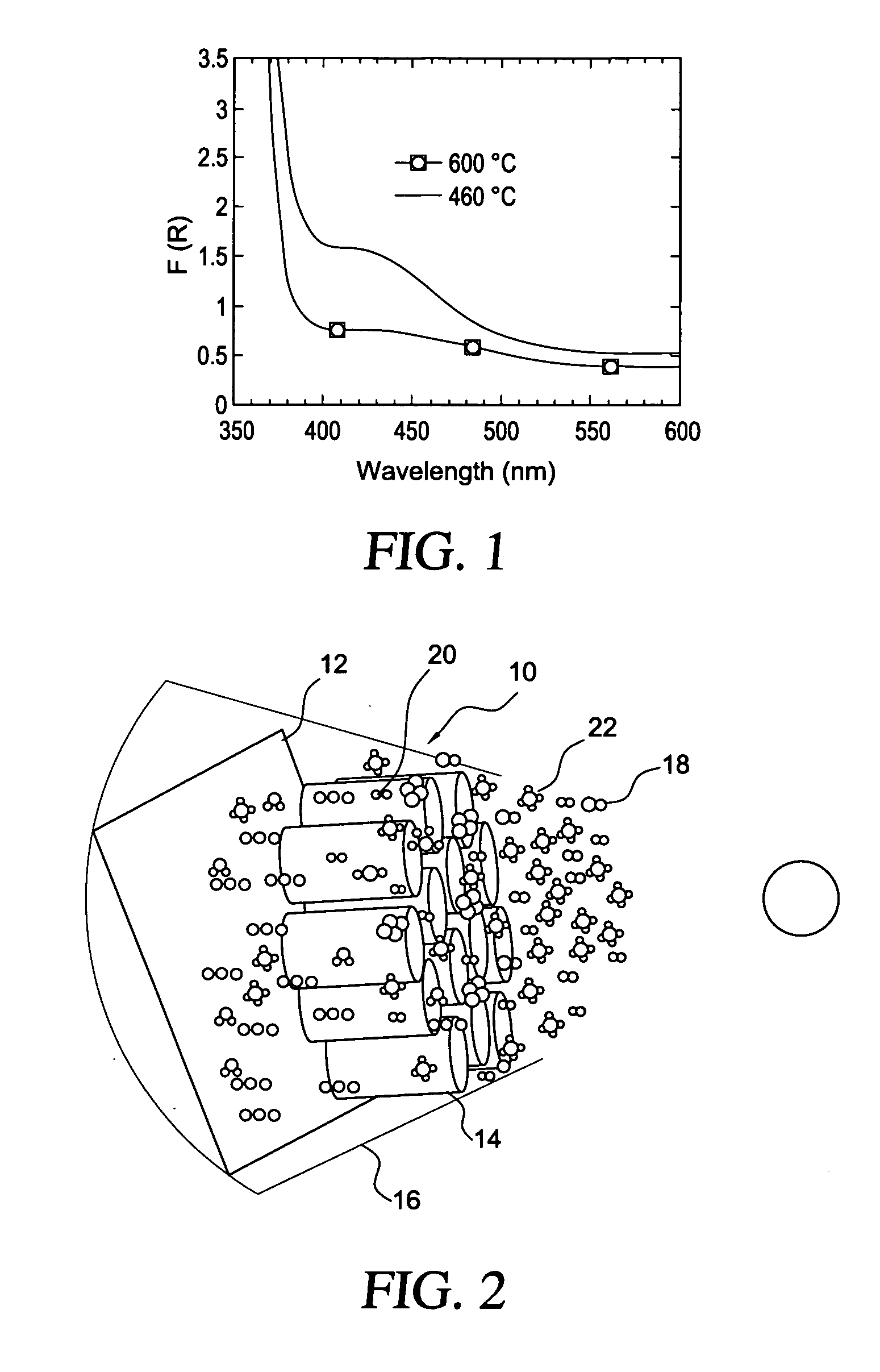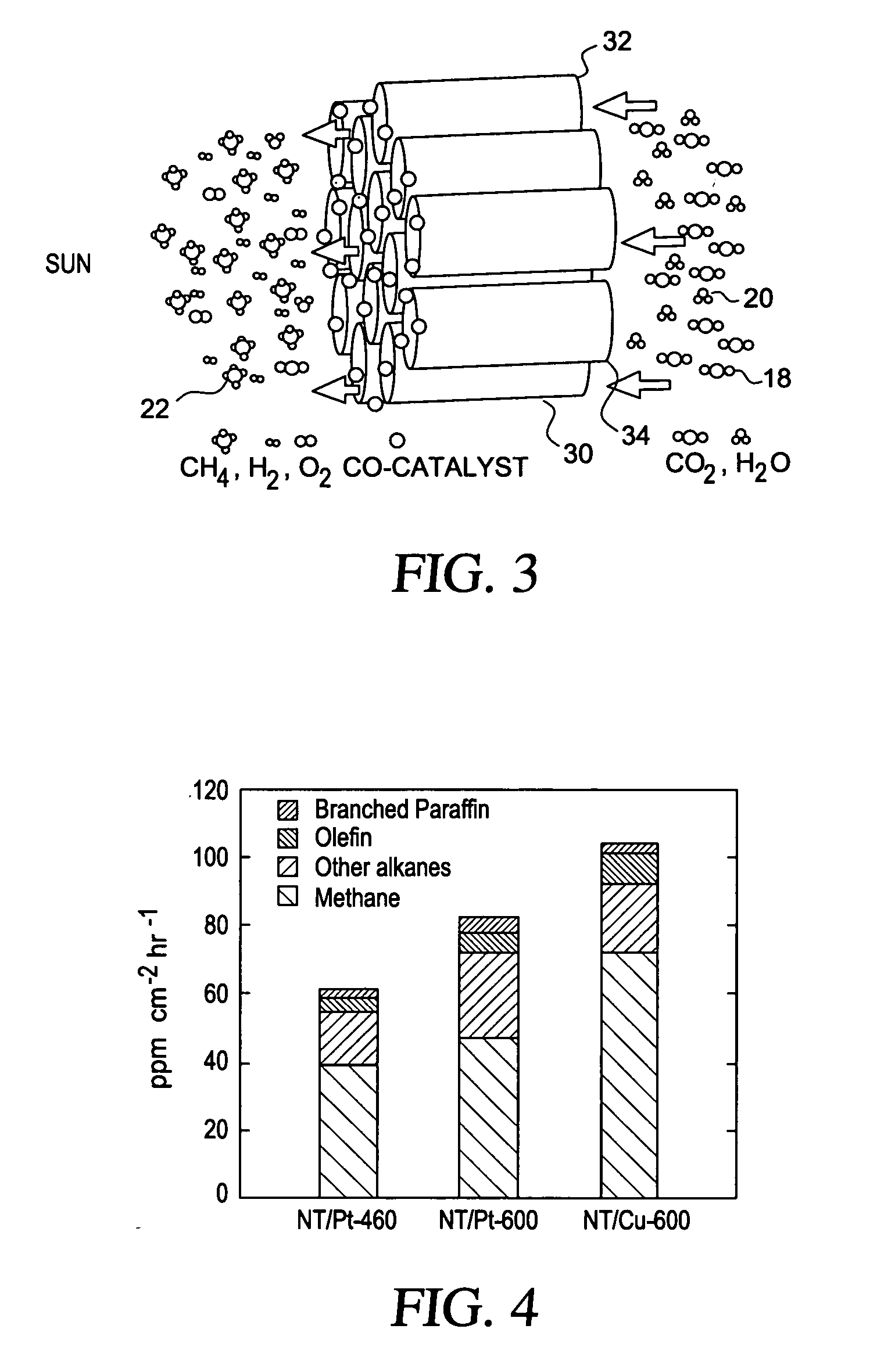Titania nanotube arrays, methods of manufacture, and photocatalytic conversion of carbon dioxide using same
a titania nanotube and carbon dioxide technology, applied in the field of nitrogen-doped titania nanotube arrays, can solve the problems of increasing atmospheric carbon dioxide concentration, affecting the efficiency of photocatalytic conversion, and affecting the efficiency of carbon dioxide recycling, so as to achieve greater photocatalytic activity and improve efficiency
- Summary
- Abstract
- Description
- Claims
- Application Information
AI Technical Summary
Benefits of technology
Problems solved by technology
Method used
Image
Examples
example 1
Preparation of Annealed, Nitrogen-Doped Titania Nanotube Array Sensitized with Platinum Nanoparticle Co-Catalysts
[0062]Nitrogen-doped TiO2 nanotube arrays of the formula TiNxO2-x, where x is 0.023 and that measured 35 μm in length were made by anodizing a titanium substrate in an ethylene glycol electrolyte that included 0.09M ammonium fluoride in 2 percent by volume water at 55V DC for a time period of 8 hours. The titanium substrate had a thickness of 250 μm (Sigma Aldrich, 99.7% purity) and was cleaned in ethanol and dried in nitrogen prior to anodization.
[0063]The nitrogen-doped titania nanotube arrays were annealed at 460° C. in air for 6 hours. Co-catalysts of Pt nanoparticles were deposited onto the annealed nitrogen-doped titania nanotube arrays by DC sputter deposition of platinum nanoparticles (DC power 1.8 W / cm2, pressure 20 mTorr, 5 cm distance between target and sample, deposition duration 13 seconds).
[0064]High-resolution transmission electron microscope (HRTEM) examin...
example 1a
[0066]The procedure of example 1 was followed except that the nitrogen-doped titania nanotube arrays were annealed at 600° C. in air. The total nitrogen concentration in the nanotubes as determined by XPS was 0.4 atom percent. The platinum-sensitized, nitrogen-doped titania nanotube arrays annealed at 600° C. are hereinafter referred to as NT / Pt600.
example 1b
[0067]The procedure of example 1 was followed except that co-catalyst of Cu nanoparticles were deposited onto the annealed nitrogen-doped titania nanotube arrays by DC sputter deposition of copper nanoparticles (DC power 1.8 W / cm2, pressure 20 mTorr, 5 cm distance between target and sample, deposition duration of 13 seconds). The copper-sensitized, nitrogen-doped titania nanotube arrays annealed at 600° C. are hereinafter referred to as NT / Cu600.
PUM
| Property | Measurement | Unit |
|---|---|---|
| Temperature | aaaaa | aaaaa |
| Temperature | aaaaa | aaaaa |
| Time | aaaaa | aaaaa |
Abstract
Description
Claims
Application Information
 Login to View More
Login to View More - R&D
- Intellectual Property
- Life Sciences
- Materials
- Tech Scout
- Unparalleled Data Quality
- Higher Quality Content
- 60% Fewer Hallucinations
Browse by: Latest US Patents, China's latest patents, Technical Efficacy Thesaurus, Application Domain, Technology Topic, Popular Technical Reports.
© 2025 PatSnap. All rights reserved.Legal|Privacy policy|Modern Slavery Act Transparency Statement|Sitemap|About US| Contact US: help@patsnap.com



